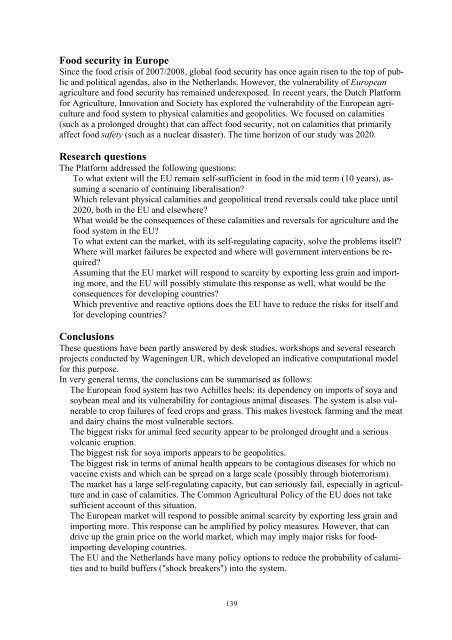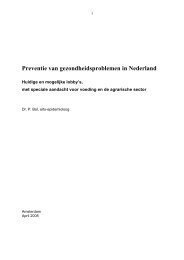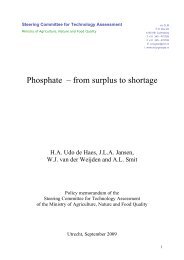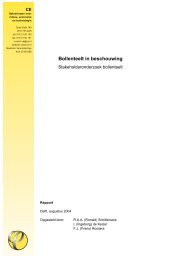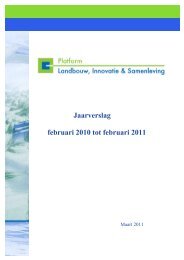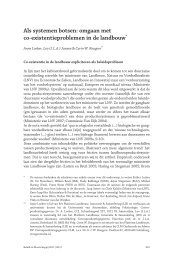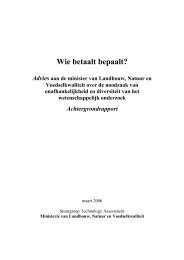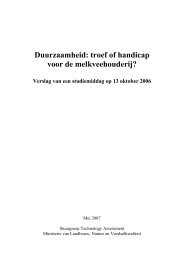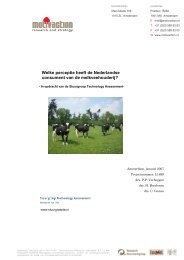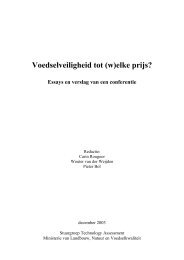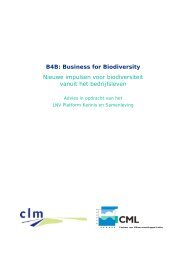De kwetsbaarheid van het Europese landbouw- en voedselsysteem ...
De kwetsbaarheid van het Europese landbouw- en voedselsysteem ...
De kwetsbaarheid van het Europese landbouw- en voedselsysteem ...
You also want an ePaper? Increase the reach of your titles
YUMPU automatically turns print PDFs into web optimized ePapers that Google loves.
Food security in Europe<br />
Since the food crisis of 2007/2008, global food security has once again ris<strong>en</strong> to the top of public<br />
and political ag<strong>en</strong>das, also in the Netherlands. However, the vulnerability of European<br />
agriculture and food security has remained underexposed. In rec<strong>en</strong>t years, the Dutch Platform<br />
for Agriculture, Innovation and Society has explored the vulnerability of the European agriculture<br />
and food system to physical calamities and geopolitics. We focused on calamities<br />
(such as a prolonged drought) that can affect food security, not on calamities that primarily<br />
affect food safety (such as a nuclear disaster). The time horizon of our study was 2020.<br />
Research questions<br />
The Platform addressed the following questions:<br />
• To what ext<strong>en</strong>t will the EU remain self-suffici<strong>en</strong>t in food in the mid term (10 years), assuming<br />
a sc<strong>en</strong>ario of continuing liberalisation?<br />
• Which rele<strong>van</strong>t physical calamities and geopolitical tr<strong>en</strong>d reversals could take place until<br />
2020, both in the EU and elsewhere?<br />
• What would be the consequ<strong>en</strong>ces of these calamities and reversals for agriculture and the<br />
food system in the EU?<br />
• To what ext<strong>en</strong>t can the market, with its self-regulating capacity, solve the problems itself?<br />
Where will market failures be expected and where will governm<strong>en</strong>t interv<strong>en</strong>tions be required?<br />
• Assuming that the EU market will respond to scarcity by exporting less grain and importing<br />
more, and the EU will possibly stimulate this response as well, what would be the<br />
consequ<strong>en</strong>ces for developing countries?<br />
• Which prev<strong>en</strong>tive and reactive options does the EU have to reduce the risks for itself and<br />
for developing countries?<br />
Conclusions<br />
These questions have be<strong>en</strong> partly answered by desk studies, workshops and several research<br />
projects conducted by Wag<strong>en</strong>ing<strong>en</strong> UR, which developed an indicative computational model<br />
for this purpose.<br />
In very g<strong>en</strong>eral terms, the conclusions can be summarised as follows:<br />
• The European food system has two Achilles heels: its dep<strong>en</strong>d<strong>en</strong>cy on imports of soya and<br />
soybean meal and its vulnerability for contagious animal diseases. The system is also vulnerable<br />
to crop failures of feed crops and grass. This makes livestock farming and the meat<br />
and dairy chains the most vulnerable sectors.<br />
• The biggest risks for animal feed security appear to be prolonged drought and a serious<br />
volcanic eruption.<br />
• The biggest risk for soya imports appears to be geopolitics.<br />
• The biggest risk in terms of animal health appears to be contagious diseases for which no<br />
vaccine exists and which can be spread on a large scale (possibly through bioterrorism).<br />
• The market has a large self-regulating capacity, but can seriously fail, especially in agriculture<br />
and in case of calamities. The Common Agricultural Policy of the EU does not take<br />
suffici<strong>en</strong>t account of this situation.<br />
• The European market will respond to possible animal scarcity by exporting less grain and<br />
importing more. This response can be amplified by policy measures. However, that can<br />
drive up the grain price on the world market, which may imply major risks for foodimporting<br />
developing countries.<br />
• The EU and the Netherlands have many policy options to reduce the probability of calamities<br />
and to build buffers ("shock breakers") into the system.<br />
139


